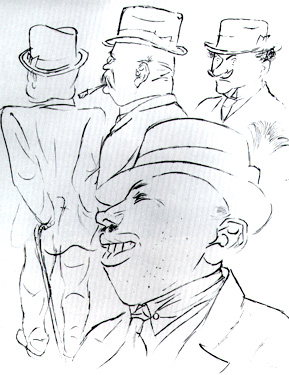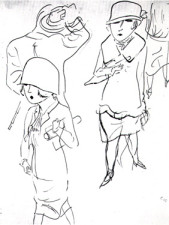
George Grosz
German, 1893-1959 (active USA)
Four Men, 1919-1920
pen and ink
SBMA, Gift of Frank Perls

Undated photograph of George Grosz
RESEARCH PAPER
Although he is associated with Dada and Expressionism, George Grosz’ unique style makes it hard to categorize him. In fact he has done work that is considered Surrealistic. More important than fitting him into any group is recognizing his ability to portray the world around him with the unflinching eye of a satirist.
Grosz began his artistic training in Dresden, where the style was extremely conservative and formal. His instructors hated the new developments in German painting coming from Berlin but he was exposed to these new trends through books and periodicals. He moved to Berlin to study where he was exposed to the German Expressionist movement.
Shortly after moving to Berlin the War of 1914-1918 broke out and he entered the military. During his short stay in the military, mostly in a hospital after an injury, he developed a deep anger and a wealth of imagery to express it. When he returned to Berlin it was to an atmosphere of growing opposition among intellectuals to the meaningless slaughter of war. The war exposed the depths of social injustice, corruption and inhumanity in German society. It was in this climate of unrest that Grosz began to depict the reality of what was happening around him. Exposure of the brutality of war and the ills of a troubled society were the themes of his art.
Although he did oils and watercolors as well, his most influential work was published in books and portfolios meant for working people, not to adorn the homes of the rich. In his simple, sketchy style, he caught the essence of the evil he saw around him. In his work he engages our emotions and, although his imagery is often frightening his vision never exceeds the limits of reality. What the writers of the time were describing he made visible. He documented the excesses of Berlin in the 1920’s with savagery but also with an underlying hope that life could and should be better. During this time he believed in the power of art to expose, attack and ultimately improve society and it was this faith that was the basis of the Dada movement. He also did stage designs for the avant-garde plays of Brecht. He incorporated innovative stage effects such as conveyor belts to move actors and props and the use of film as a backdrop.
Grosz left Germany shortly before the rise of Nazism, which he documented as early as 1922. He went to America where he taught art. He became pessimistic and lost his faith in the power of art to create social change.
He has left us with a wealth of documents on the history of early 20th century Germany, a history in which he took an active part. His ability to use line, the tilting of space and exaggeration to describe atmosphere and character transcends his time and makes his imagery as powerful now as when first created.
Bibliography
1. Heckscher Museum, “George Grosz-Works in Oil”, Huntington, New York, 1977.
2. Hirshhorn Museum and Sculpture Garden, “George Grosz”, 1978.
3. Hofstra University, “George Grosz: An artist for 1984”, 1984.
Prepared for the Docent Council
By Ronda Quaid, 1992
Website preparer: Deanna Major, 2004

Also in SBMA collection by George Grosz, Young Ladies, 1919-1920, pen and ink, gift of Frank Perls.
